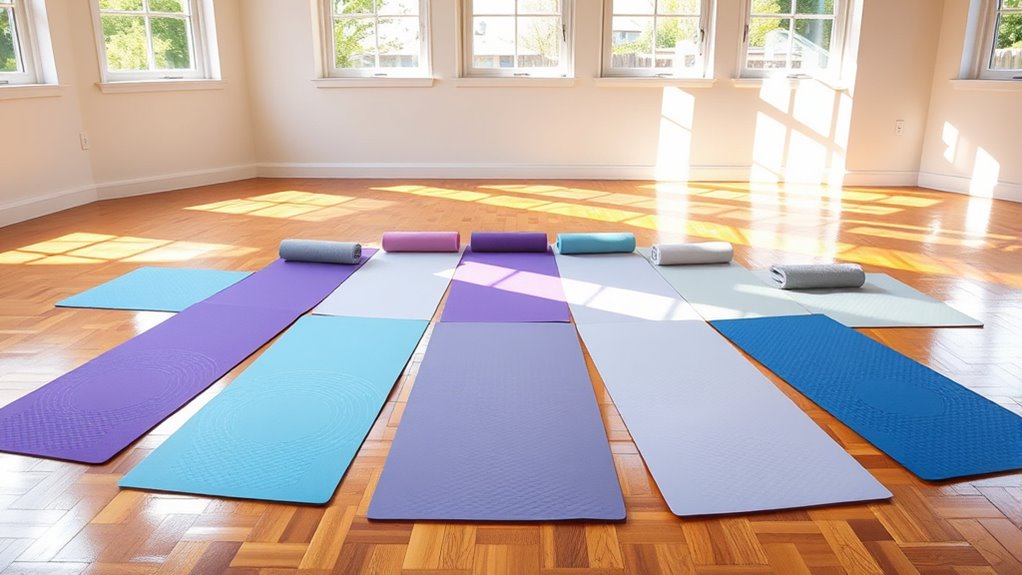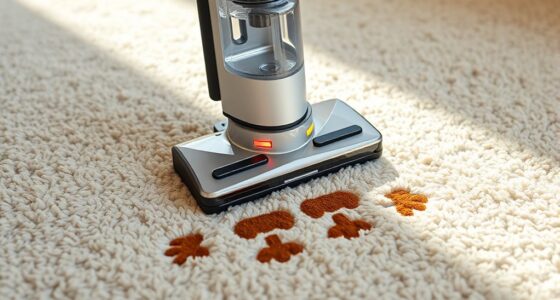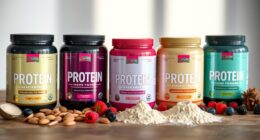If you’re starting yoga and need a dependable non-slip mat, I recommend considering options like the Retrospec Solana or Gaiam Print mats, which offer great grip and cushioning. Mats with textured surfaces, eco-friendly materials, and portability features help boost your confidence and stability. Thicker mats provide extra comfort, while lightweight designs are easier to carry. Keep an eye on durability and size to match your needs—more tips below will help you choose the perfect one.
Key Takeaways
- Prioritize mats with textured or patterned surfaces made from TPE, PVC, or eco-friendly materials for reliable grip and slip resistance.
- Choose the appropriate thickness (4mm to 8mm) for comfort, joint support, and stability during various yoga poses.
- Consider lightweight, portable mats with straps or bags for easy transport and storage, ideal for beginners on the go.
- Opt for non-toxic, eco-friendly materials certified by safety standards to ensure a healthy practice environment.
- Assess durability and ease of maintenance to ensure the mat remains non-slip and in good condition over time.
Retrospec Solana Yoga Mat with Nylon Strap

If you’re a beginner looking for a comfortable yet stable yoga mat, the Retrospec Solana Yoga Mat with Nylon Strap is a top choice. Its extra 1/2-inch thickness cushions joints, hips, and knees during floor exercises, making your practice more comfortable. Made from high-density TPE, it offers a non-slip surface that keeps you stable through challenging poses. The 72×24-inch size is perfect for various routines, and at just over a kilogram, it’s easy to carry with the included nylon strap. Plus, it’s durable, easy to clean, and safe—ideal for both home and studio use.
Best For: Beginners and intermediate users seeking a comfortable, stable, and portable yoga mat for diverse workout routines at home or in the studio.
Pros:
- Extra 1/2-inch thickness provides superior cushioning for joints, hips, and knees.
- Non-slip, high-density TPE surface ensures stability and safety during challenging poses.
- Lightweight design with nylon strap makes it easy to carry, store, and transport.
Cons:
- Hand wash only, which may be less convenient than mats that are machine washable.
- Slightly heavier than thinner mats, which might be a concern for some users seeking ultra-lightweight options.
- Limited color options beyond Rose, possibly reducing choices for personal preference.
Gaiam Print Yoga Mat for Yoga, Pilates & Floor Exercises

The Gaiam Print Yoga Mat stands out as an excellent choice for beginners seeking a reliable, versatile surface for yoga, Pilates, and floor exercises. Its textured, non-slip surface offers superior grip, ensuring safety during any routine. Made from non-toxic, 6P-free PVC, it promotes a healthier environment and reduces odors with proper airing. At 68 inches long and 4mm thick, it provides ample cushioning to protect joints while remaining lightweight and portable. Plus, it includes a free downloadable workout, perfect for beginners looking to build confidence and consistency in their practice. Overall, this mat combines safety, comfort, and style for a well-rounded practice experience.
Best For: Beginners and casual practitioners seeking a safe, comfortable, and versatile yoga mat for yoga, Pilates, and floor exercises.
Pros:
- Non-toxic, 6P-free PVC material promotes a healthier practice environment
- Textured non-slip surface provides excellent traction for safety and stability
- Lightweight and portable, making it easy to transport and store
Cons:
- May have a slight initial odor that requires airing out before use
- Thickness (4mm) might not provide enough cushioning for those needing extra joint support
- Design options may be limited in style or color choices
Yoga Mat Non Slip, Eco Friendly Fitness Exercise Mat with Carrying Strap

For beginners seeking a reliable, eco-friendly yoga mat, the Gruper Non-Slip Fitness Exercise Mat with Carrying Strap stands out as an excellent choice. Made from premium thermoplastic elastomers (TPE), it’s safer and softer than traditional PVC or EVA mats, though pricier. Its double-layer design boosts durability and resists tearing or deformation. Both sides feature a textured, non-slip surface that provides excellent grip, ideal for yoga, Pilates, or general fitness. Available in standard and thickened options, it’s lightweight and comes with a carrying strap and storage bag, making it perfect for on-the-go practice while prioritizing environmental safety.
Best For: beginners and eco-conscious fitness enthusiasts seeking a durable, non-slip yoga mat for versatile workouts.
Pros:
- Made from eco-friendly, premium thermoplastic elastomers (TPE) that are safer and softer than traditional PVC/EVA mats.
- Double-layer design enhances durability, resistance to tearing, and deformation.
- Non-slip textured surface on both sides provides excellent grip for various exercises, suitable for barefoot use.
Cons:
- Slightly more expensive than traditional PVC or EVA mats.
- May be damaged if used with shoes or pet paws, requiring careful handling.
- Not suitable for prolonged sun exposure or machine washing; requires gentle cleaning and flat drying.
Yoga Mat Non Slip, Pilates Fitness Mats, Eco Friendly, Anti-Tear 1/4″ Thick Yoga Mats

When starting out with yoga or Pilates, choosing a mat that provides reliable grip and durability is essential, especially for beginners. I recommend the UMINEUX eco-friendly TPE mat, which features double-sided non-slip surfaces with textured patterns and wavy undersides for excellent traction. Its 1/4 inch thickness offers comfort and support without sacrificing stability. Plus, it’s lightweight, skin-friendly, and recyclable, making it eco-conscious. The anti-tear design guarantees longevity through regular use. With a free carrying strap and storage bag, it’s easy to take anywhere. This versatile mat is perfect for all levels, providing safety and comfort for your practice.
Best For: beginners and eco-conscious practitioners seeking a durable, non-slip yoga or Pilates mat for all levels of exercise.
Pros:
- Eco-friendly TPE material that is recyclable and free from harmful chemicals
- Double-sided textured non-slip surfaces for excellent floor traction
- Lightweight design with a free carrying strap and storage bag for portability
Cons:
- Not suitable for use with shoes or pet paws, which may cause tears
- Requires careful cleaning with a damp cloth and air drying; not machine washable
- Less cushioning than thicker mats, which may be less comfortable for high-impact activities
Fitvids 1/4-Inch Yoga Mat with Carrying Strap

If you’re searching for a reliable yoga mat that combines comfort with portability, the Fitvids 1/4-Inch Yoga Mat with Carrying Strap is an excellent choice. Its 1/2-inch high-density foam provides exceptional cushioning, supporting your spine, hips, knees, and elbows during yoga, Pilates, or floor exercises. The dual-sided non-slip surface ensures a solid grip, helping you maintain balance and prevent injuries. Made from resilient, moisture-resistant material, it withstands regular use and is easy to clean. Plus, its lightweight design and included carrying strap make it simple to transport to class or home, making it perfect for all body types and practice styles.
Best For: individuals seeking a comfortable, portable yoga mat suitable for various exercises and all body types.
Pros:
- Provides superior cushioning with 1/2-inch high-density foam for added comfort and support.
- Dual-sided non-slip surface enhances grip, ensuring safety and stability during workouts.
- Lightweight and includes a carrying strap for easy transportation to gym, studio, or home.
Cons:
- Thicker mats may be less ideal for those preferring a more minimalistic feel.
- High-density foam might be slightly heavier than thinner mats, affecting portability for some users.
- As with all foam mats, prolonged exposure to moisture or dirt may require regular cleaning to maintain grip and hygiene.
Retrospec Solana Yoga Mat with Nylon Strap

The Retrospec Solana Yoga Mat with Nylon Strap is an ideal choice for beginners who want extra comfort and stability during their practice. Its 1/2-inch thickness offers excellent cushioning for joints, hips, and knees, making floor exercises more comfortable and reducing fatigue. The non-slip surface provides a secure grip, helping me stay balanced and focused on my form without slipping. Built to last, this mat withstands daily use and intense workouts, perfect for both home and studio sessions. Plus, the included nylon strap makes it easy to roll up and carry, simplifying transport and storage. It’s made from health-conscious, BPA-free materials, easy to clean and maintain.
Best For: beginners and practitioners seeking extra cushioning and stability for home or studio yoga with easy portability.
Pros:
- Provides ample 1/2-inch cushioning to protect joints and reduce fatigue during poses.
- Features a non-slip surface for secure grip and enhanced stability.
- Durable construction suitable for daily use and intense workouts, with an included nylon strap for easy transport.
Cons:
- May be too thick for advanced practitioners who prefer a closer connection to the floor.
- Slightly heavier than thinner mats, which could affect portability for some users.
- Requires regular cleaning to maintain grip and freshness, especially after intense sessions.
Instructional Yoga Mat with Carrying Strap

The Instructional Yoga Mat with Carrying Strap stands out as an excellent choice for beginners seeking guidance during their practice. With 75 illustrated poses and 75 stretching exercises printed directly on the mat, it’s perfect for self-guided sessions or following along without an instructor. Measuring 68”x24” with a 1/4-inch thickness, it offers extra cushioning for knees and joints, enhancing comfort during longer holds. Made from eco-friendly, non-toxic PVC, it’s durable and safe. The included carrying strap makes transportation easy, so you can practice anywhere—at home, in the studio, or outdoors—without hassle.
Best For: beginners and experienced yogis seeking a comprehensive, portable, and easy-to-follow yoga mat for self-guided practice or classes.
Pros:
- Features 75 illustrated poses and stretching exercises printed directly on the mat for convenient reference.
- Offers extra cushioning with a 1/4-inch thickness, providing comfort for knees and joints during longer sessions.
- Made from eco-friendly, non-toxic PVC, ensuring safety, durability, and quick odor dissipation.
Cons:
- Larger size (68”x24”) may be less suitable for users with limited storage space.
- The printed illustrations might fade over time with extensive use.
- Some users may prefer a slightly thicker or more cushioned mat for high-impact or restorative practices.

For beginners seeking reliable grip and comfort during their yoga practice, the Gaiam Yoga Mat with a 6mm thickness offers an excellent combination of stability and cushioning. Its textured, sticky surface guarantees excellent traction, preventing slips during poses. Made from non-toxic, eco-friendly PVC free of harmful chemicals, it’s safe for both you and the environment. The extra cushioning provides joint protection, making it ideal for floor exercises like Pilates. Lightweight and durable, it’s easy to carry and maintain. With high customer ratings and a stylish design, this mat balances safety, comfort, and eco-consciousness—perfect for those starting their yoga journey.
Best For: beginners and practitioners seeking reliable grip, cushioning, and eco-friendly materials for yoga, Pilates, and floor workouts.
Pros:
- Excellent non-slip textured surface ensures safety during various poses
- 6mm thickness provides optimal cushioning for joints and comfort
- Made from non-toxic, eco-friendly PVC, promoting health and environmental sustainability
Cons:
- Might require airing out for a few days to eliminate initial odor
- Slightly heavier than thinner mats, which may affect portability for some users
- Limited color options depending on availability
Yoga Mat Non Slip TPE with Carrying Strap and Bag

If you’re just starting out with yoga or other floor exercises, the Gruper Yoga Mat’s non-slip TPE surface offers reliable grip, ensuring stability during your practice. Made from eco-friendly, odorless TPE, it’s safe for beginners and athletes alike. It comes with a free carry strap and bag for easy portability, making it perfect for on-the-go workouts. Available in 6mm and 8mm thickness options, it provides comfort and support whether you’re practicing yoga, Pilates, or meditation indoors or outdoors. The textured double-layer design enhances durability and tear resistance, while the alignment system helps you maintain proper posture. It’s a reliable, versatile choice for your practice.
Best For: Beginners and athletes seeking a non-slip, eco-friendly yoga mat with added cushioning for indoor and outdoor workouts.
Pros:
- Made from eco-friendly, odorless TPE material safe for all users
- Non-slip textured surface on both sides for enhanced grip and safety
- Comes with a free carry strap and bag for convenient portability
Cons:
- Thicker options may be less portable for some users
- Requires careful cleaning; avoid machine washing to maintain durability
- Designed for barefoot use; shoes or pet paws can damage the surface
Retrospec Solana Yoga Mat with Nylon Strap
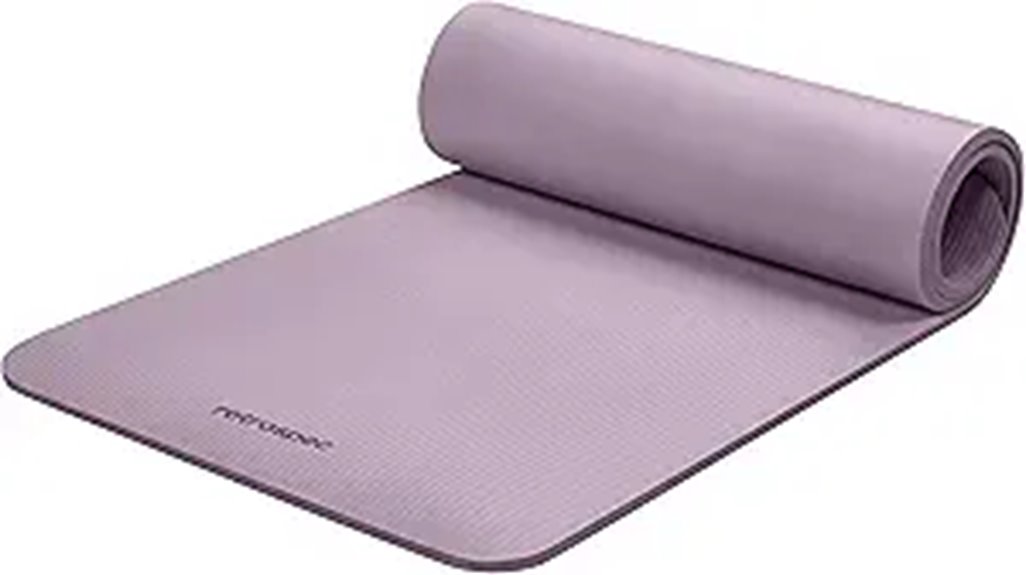
With its 1/2-inch thick design, the Retrospec Solana Yoga Mat offers exceptional cushioning that supports joints, hips, and knees during floor exercises. This extra padding enhances comfort and stability in various poses, making it ideal for both beginners and seasoned practitioners. The non-slip surface ensures a secure grip, reducing the risk of slipping and maintaining balance throughout your practice. Built for durability, it withstands daily use and intense workouts, whether at home or in the studio. Plus, the included nylon strap makes it easy to roll, carry, and store, adding convenience to your yoga routine. It’s a reliable, health-conscious choice.
Best For: yoga practitioners of all levels seeking comfortable, stable, and durable flooring for their routines.
Pros:
- Provides 1/2-inch thick cushioning for enhanced joint and knee support.
- Features a non-slip surface for secure grip and stability during exercises.
- Comes with a convenient nylon strap for easy carrying and storage.
Cons:
- Slightly thicker mats may be less portable for some users.
- May require regular cleaning to maintain grip and freshness.
- Made from BPA-free materials, but some users might prefer eco-friendly options.
Factors to Consider When Choosing a Yoga Mat for Beginners Non Slip
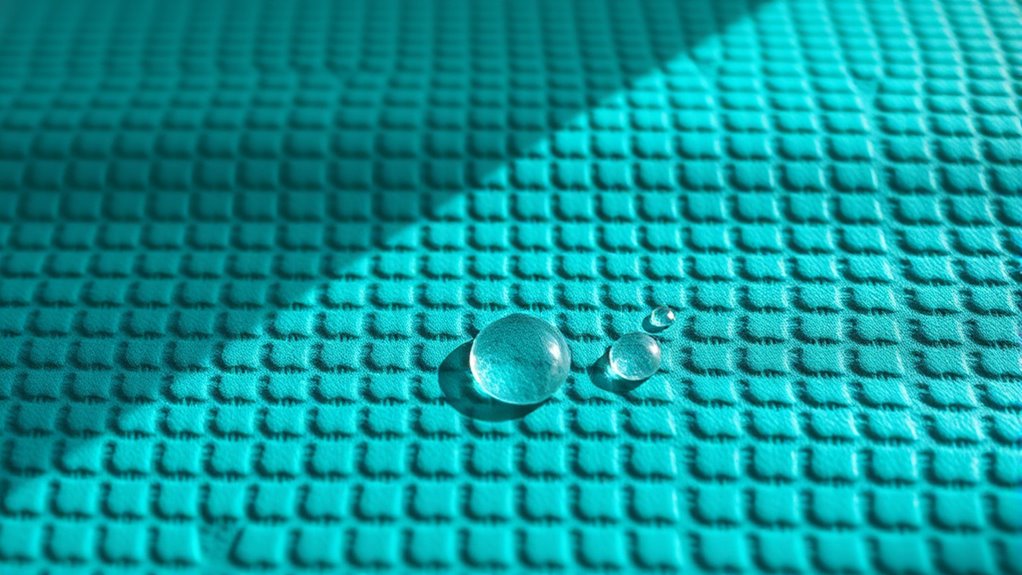
When choosing a non-slip yoga mat, I focus on the surface material’s grip and durability to prevent slipping. I also consider the thickness for comfort, the size that fits my space, and portability for easy transport. Finally, I check that the materials meet safety standards to guarantee my practice is both safe and effective.
Anti-Slip Surface Material
Choosing the right anti-slip surface material is essential for ensuring safety and confidence during your yoga practice. I look for mats with textured surfaces made from durable materials like TPE, PVC, or thermoplastic elastomer because they provide excellent grip, especially when I sweat. Double-sided textured designs are beneficial, offering traction on various floor types and during different poses. It’s also important that the material maintains its grip over time, resisting deformation and wear from frequent use. A non-slip surface helps me feel secure, allowing me to focus on my poses without slipping or sliding. Ultimately, selecting a mat with a reliable anti-slip surface boosts my stability, encourages proper alignment, and builds confidence as I progress in my practice.
Cushioning Thickness Level
Selecting the right cushioning thickness for my yoga mat is essential because it directly affects my comfort and stability during practice. I’ve found that a thickness between 4mm and 6mm offers the best balance, providing enough joint protection without compromising my balance. Thicker mats, like 1/2 inch (12mm), feel more comfortable but can make balancing poses more challenging. On the other hand, thinner mats, around 1/8 inch (3mm), improve stability but may lack sufficient cushioning for sensitive joints. For beginners, a medium thickness helps maintain control while protecting joints, making it easier to focus on alignment and breath. Choosing a moderate thickness helps me stay safe and effective in my practice, no matter the pose.
Mat Size Compatibility
The size of your yoga mat plays a essential role in ensuring comfort and stability during practice. It’s important to choose a mat that provides enough space for your full body to move freely, typically at least 68 inches long and 24 inches wide. If you’re taller or have a wider arm span, look for larger mats to avoid feeling restricted. Consider your workout space, especially if you practice in small studios or confined areas—select a size that fits comfortably without crowding. A properly sized mat also allows smooth progressions between poses, reducing the need to reposition frequently. Ultimately, the right size helps you stay focused and confident, supporting your practice without distractions or discomfort.
Portability Features
Portability is a key factor for beginners looking for a non-slip yoga mat, especially if you often practice outside your home or move between classes. Lightweight mats with carrying straps or handles make transportation simple, so you can easily carry them to the park, studio, or gym. Compact, foldable designs are perfect for those with limited space or when traveling, allowing for quick storage and easy packing. Many portable mats come with accessories like storage bags or straps, which protect your mat and make carrying even more convenient. Thinner mats tend to be lighter, easing the weight you carry, but still need to offer enough grip and cushioning for safety. Overall, look for mats that strike a balance between lightweight design and functionality.
Material Safety Standards
Choosing a non-slip yoga mat that’s safe for beginners means paying close attention to the materials used. I always look for mats made from non-toxic, BPA-free substances to avoid skin irritation and health risks. Certifications like SGS ensure the product meets strict safety standards, giving me peace of mind. I prefer environmentally friendly options like TPE or natural rubber because they’re free from harmful chemicals often found in PVC. It’s also essential to verify that the materials have been tested for durability and slip resistance, preventing accidents during practice. I check product labels or manufacturer details to ensure compliance with safety regulations, so I can focus on my practice without worrying about potential health hazards. Prioritizing safety standards helps me find a reliable, healthy yoga mat.
Ease of Cleaning
A yoga mat that’s easy to clean makes maintaining hygiene simple and hassle-free. I look for mats that can be wiped down with soap and water or a mild detergent, which keeps them fresh without much effort. Mats made from non-toxic, BPA-free materials are ideal because they clean easily without damaging the surface or compromising safety. It’s important that the textured or non-slip surface remains intact after cleaning, so routine wipes won’t compromise grip or safety. I avoid mats that require special cleaning solutions or deep cleaning, as those can be inconvenient for regular use. Additionally, a material resistant to stains and odors makes quick cleanups effective, ensuring my practice space stays clean, fresh, and ready for every session.
Durability & Tearing Resistance
Since easy-to-clean mats stay fresh longer, investing in a durable one guarantees it can handle regular use without falling apart. A good yoga mat should be made from tear-resistant materials like TPE or high-density PVC, which stand up to frequent practice. Double-layer construction further enhances its ability to resist tearing and deformation over time, especially during intense poses. Thicker mats, at least 1/4 inch, offer extra resilience, reducing the risk of tearing during sustained stretches or jumps. The surface also matters—non-slip textured designs help prevent excessive strain that could damage the mat prematurely. Proper care, such as regular cleaning and avoiding sharp objects, profoundly extends your mat’s lifespan. Prioritizing durability ensures your investment pays off, providing reliable support as you progress in your practice.
Eco-Friendly Options
Have you ever wondered how your yoga mat’s materials impact both your practice and the environment? Eco-friendly yoga mats are made from sustainable materials like natural rubber, TPE, or recycled plastics, which help reduce environmental harm. These mats are free from harmful chemicals such as PVC, phthalates, and heavy metals, creating safer spaces for your practice. Many eco-conscious options are biodegradable or recyclable, making disposal responsible and minimizing landfill waste. Additionally, producing these mats generally results in lower carbon emissions and less pollution compared to traditional synthetic mats. By choosing eco-friendly options, you support brands committed to sustainability and promote environmentally responsible manufacturing. It’s a simple way to align your yoga practice with your values and protect the planet.
Frequently Asked Questions
How Do I Clean and Maintain My Non-Slip Yoga Mat?
You should clean your non-slip yoga mat regularly with a gentle soap or a mixture of water and vinegar. I recommend wiping it down after each use to remove sweat and dirt, which helps maintain its grip. Avoid harsh chemicals or machine washing, as they can damage the surface. Let it air dry completely before rolling it up, and store it in a cool, dry place to prolong its life.
Which Thickness Is Best for Beginner Comfort and Stability?
Honestly, I’d pick a mat around 4 to 6mm thick. It’s like Goldilocks’ porridge—just right for comfort and stability without turning into a giant sponge or a super thin pancake. Thinner mats offer better balance, while thicker ones cushion joints. As a beginner, this middle ground helps you stay steady and comfortable, making your practice more enjoyable and less prone to slipping or wobbling.
Are Eco-Friendly Mats as Durable as Traditional Mats?
Eco-friendly mats can be just as durable as traditional ones if you choose the right brand. I’ve found that many eco-friendly options use high-quality natural or recycled materials designed to withstand regular use without tearing or losing grip. While some might worry about longevity, I’ve been pleasantly surprised by how well these mats hold up over time, making them a great sustainable choice for your practice.
Can I Use a Non-Slip Yoga Mat on Uneven Surfaces?
Absolutely, you can use a non-slip yoga mat on uneven surfaces, but it’s like trying to balance a flaming torch on a trampoline—requires focus! I recommend placing your mat over a stable, flat surface or using a thick, supportive mat designed for outdoor or uneven terrain. This way, you stay steady, safe, and truly enjoy your practice without any wobbles or slips.
How Do I Improve Grip if My Mat Becomes Slippery?
If your mat gets slippery, I recommend wiping it down with a damp cloth and using a bit of mild soap if needed. You can also sprinkle some talcum powder or cornstarch on the surface to absorb moisture and improve grip. Additionally, guarantee your hands and feet are clean and dry before practicing. Sometimes, switching to a towel or using grip-enhancing sprays can make a big difference too.
Conclusion
Choosing the right non-slip yoga mat can truly transform your practice. With so many options, it’s about finding one that feels just right—supportive, durable, and safe. But the perfect mat might be more elusive than you think. Are you ready to discover the one that keeps you grounded, confident, and ready to push your limits? Your ideal yoga journey begins now—are you prepared to take that next step?
